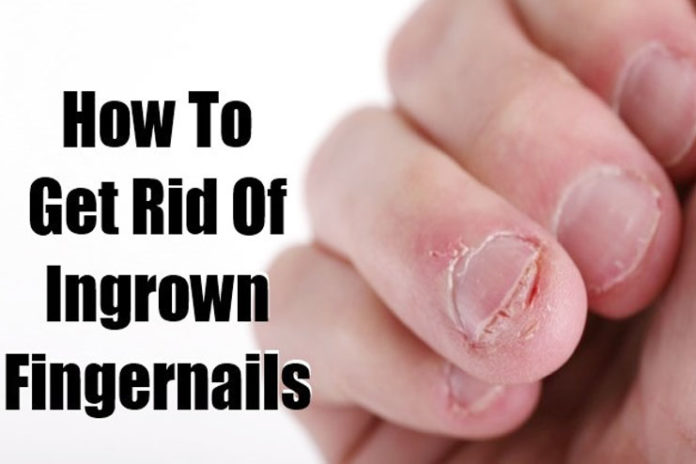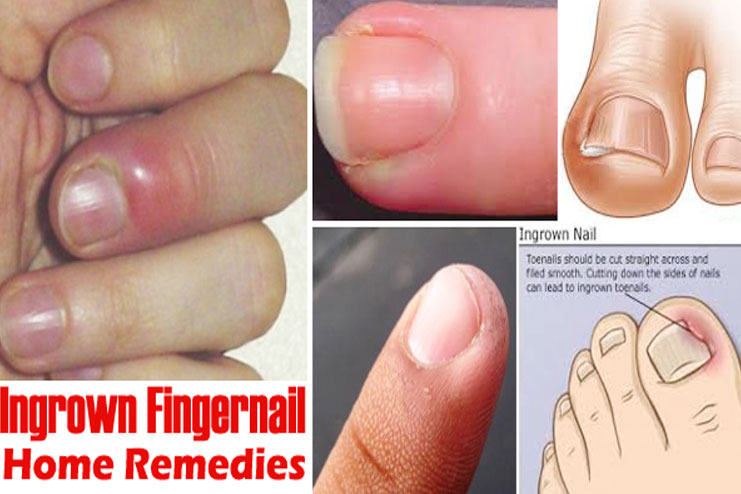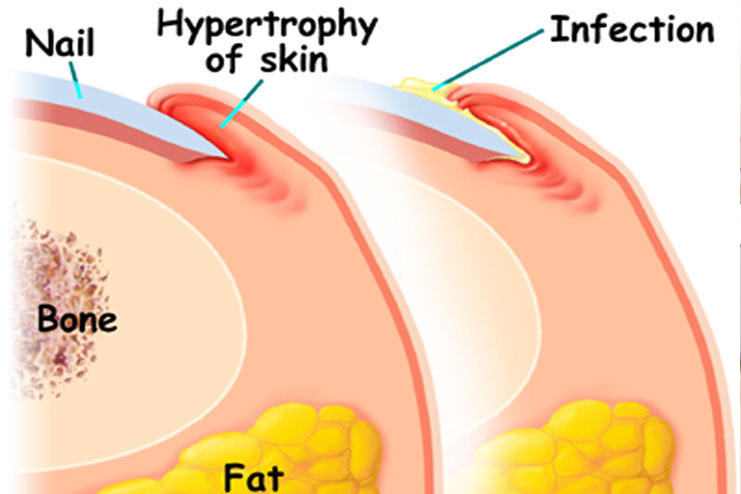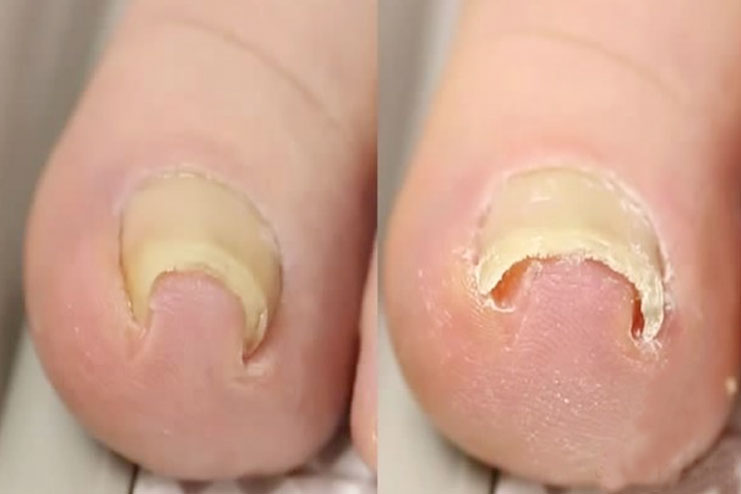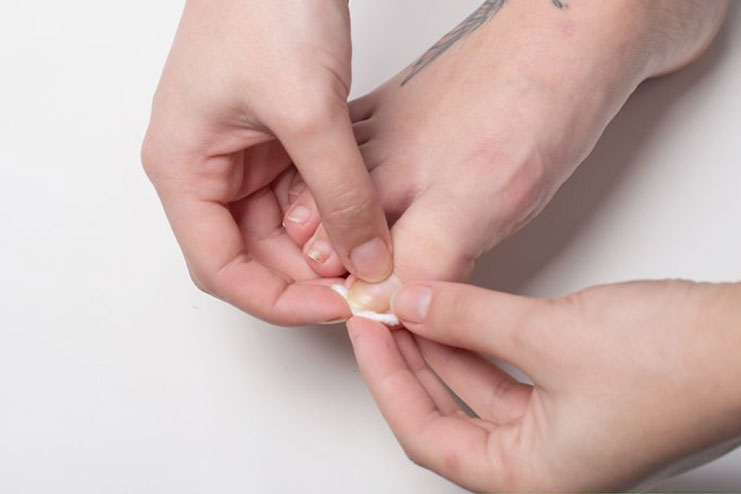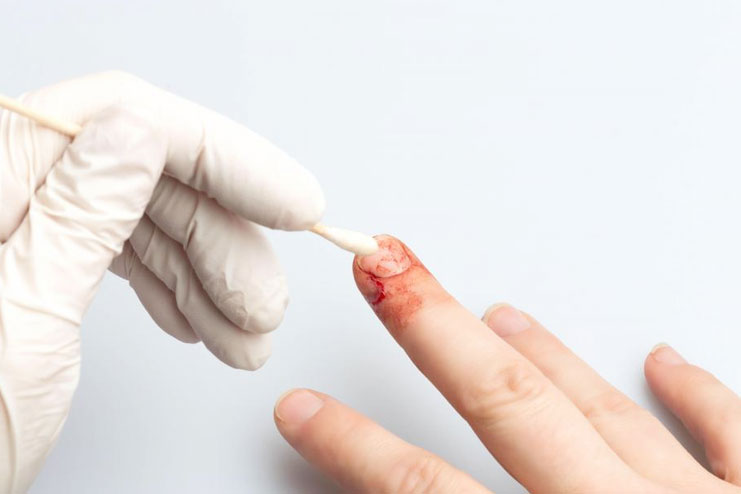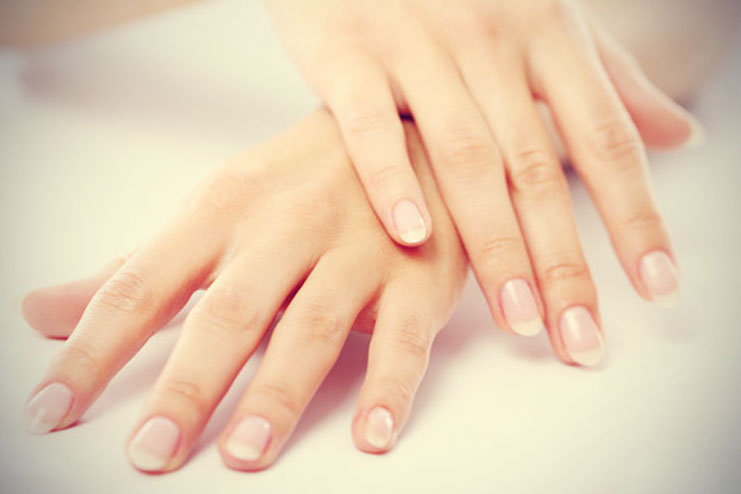Affiliate Disclaimer
Some links in this article are affiliate links. We may earn a small commission if you make a purchase through these links, at no extra cost to you. We only recommend products we find useful to our readersAn ingrown fingernail is also known as onychogryphosis medically. It can be extremely painful and even get infected if left untreated. An ingrown fingernail is a very common condition in which the nail grows to cut one or both sides of the nail bed. It begins as a microbial inflammation and causes the fingernail grown deep buried deep inside. Ingrown toes nails can occur both in hands and feet but toenails have been more prominently infected by them
What is Ingrown Fingernail:
An ingrown fingernail is simply a nail growing into the flesh rather than over it. People with curved or thick nails are more susceptible to ingrown fingernails. It can also occur due to poor shoe fitting, injury, improper hygiene, and diabetes.
A damaged or improperly trimmed nail can become ingrown, burrowing into the skin and the sides of the nail. This gets infected and painful if not treated. This can even result in getting the nail removed for further relief. This ingrown fingernail, where the edge of the fingernails grows into the skin surrounding it.
This nail curves down into the surrounding skin of the nails as it grows which prompts the skin to grow over this nail thus fingernail grown inside the skin.
Check How to get rid of yellow nails at home
Signs and Symptoms of Ingrown Fingernails:
Some of the most prominent symptoms and signs of ingrown fingernails can be seen even at home. These need immediate attention o they become painful and infected. The signs and symptoms of ingrown fingernails include:
- Pain along the margins of the nails caused by Hyper granulation
- Extremely vulnerable and sensitive skin around the ingrown fingernail, which feels immense pressure even with light weight clothes
- Tapping and bumping producing excruciating pain around the ingrown thumbnail
- When they get infected the signs are redness and swelling around the nail – Pus discharge
- Watery discharge mixed with blood
- Swelling at the base of the nail from where ingrown fingernail is coming out
- Discoloration of skin around ingrown fingernail
- Bulge beneath the skin
What are the Causes for Ingrown Fingernails:
The main cause of ingrown toenail is footwear, which is ill-fitted and uncomfortable. This includes shoes with inadequate toe box room and tight sticking that apply pressure to the top or side of the foot. Some of the common causes of ingrown fingernails are:
1- Ill fitted shoes which cause bunching of toes and thus makes the nail to curl and dig into the skin. These ill fitted shoes are either too narrow or too short.
2- Improper nail care and poor nail hygiene. This includes cutting nails too short, deeply rounded from the tip, peeled off from edges instead of being straight cut. Or breaking the nail from its roots
3- Injury or trauma of the nails caused by stubbing the toe or fingernail, dropping things on the nails, injury of the flesh of the fingernails, irregularity in nail growth because of these injuries also causes the ingrown fingernail
4- Abnormally shaped nail beds, nail deformities arising from diseases, genetic reasons are all causes for ingrown fingernails.
5- A bacterial ingrown fingernail infection which can be treated with antibiotics.
6- Naturally curved nails which are large and thick
7- Biting nails and leaving the edges ruptured
8- Poor manicure or pedicure giving bacterial infections and causing ingrown fingernails.
Natural nail care tips for healthy and beautiful nails
Natural home treatment for ingrown fingernails:
Home remedies to get rid of ingrown fingernails are the primary resort to in nail deformity. If you see pus or severe pain immediately see your healthcare provider. Some of the ingrown fingernails remedies at home include:
1- Soaking ingrown Fingernails in warm water:
Warm water provides immediate relief and soothes the inflammation. You just need to soak the fingernails in moderately warm water to use this remedy. All you need is warm water tub and some dry towel
Procedure:
- Take some warm water in a large tub enough to soak your nails in it
- Now soak your fingernails and toenails in it
- Let them stay under warm water for 20 minutes
- Now take our the hands and feet, let them dry and bit and then wipe them with dry towel
- Remember damp and wet nails can cause the bacteria to multiply. So do not let your hands stay wet, only for the time you soak them in warm water else keep them dry.
- Repeat this at least 5-6 times a day for faster relief
- Once you see your nail bed and nail soft, use a clipper to trim the ingrown fingernail
- Do not push the ingrown fingernail down or injure the skin around, if you can not see it then don’t proceed further
2- Vinegar Water Soaks to Reduce Ingrown Fingernail:
Vinegar is a naturally occurring acid which balances the pH level of skin, provides disinfectant benefits, deep cleanses and heals the skin too.Use any from vinegar or apple cider vinegar.
Procedure:
- Mix one part of apple cider vinegar to 4 parts of water
- Now soak your hands and feet in this water
- Let it be inside for 20 minutes
- Now take our the hands and feet and dry them properly using a towel
- Repeat 3 times a day for immediate relief
3- Use a Cotton Ball to Lift the Ingrown Fingernail:
Under this procedure, you must give a proper direction to the nail to grow further. Normally our nails grow 2-3mm every month. Using a cotton ball you can lift the nail and give them proper direction to progress ahead with
Procedure:
- Take a piece of cotton ball and wedge it under the edge of your nail where it is getting ingrown.
- Use tweezers for harder skin but be careful not to hurt
- Proceed with this just after soaking the fingers in warm water, as that’s when the nails and skin on edges os softer. This would not create any further pain and can easily provide the necessary lift we are looking for.
- Keep doing it for 15-20 minutes as this will help in making the ingrown fingernail grow away from the flesh and not within the skin
- Keep doing it for a few weeks until you see no more ingrowth and pain
- Don’t let the cotton stay in the wedge for more than a day. Else this will make the nail get infected easily.
4- Epsom Salt Soaks for Ingrown Fingernail Treatment:
Epsom salt is not a salt but a naturally occurring pure mineral compound of magnesium and sulfate. These two minerals are readily absorbed by our skin surface making Epsom an ideal ingredient with health benefits. It also is a specialist method to help you get relief from the excruciating pain of ingrown fingernails.This helps cure the pain and tenderness of the nails, also clearing the infection too. You just need Epsom salt and warm water
Procedure:
- Add 2 teaspoon Epsom salt to one quart of warm water
- Soak your hands and feet for about 20 minutes.
- Dry out properly with a towel.
- Repeat 3 to 4 times a day
5- Hydrogen peroxide for ingrown fingernail treatment:
Hydrogen peroxide is a naturally occurring disinfectant. It is chemical water with an extra molecule of oxygen H2O2. This natural component can be found in traces of rain and snow. Even our own immune system creates and uses hydrogen peroxide to regulate and control bacteria and viruses. Medically it is used as a topical disinfectant.
It is extremely toxic so utmost care must be taken when using it. Always use 35% food grade hydrogen peroxide after diluting it in water. It is safe to use as a 3% solution which is made by adding 1 ounce of 35% food grade H2O2 with 11 oz of water.
Procedure:
- Add 1 cup H2O2 in half bucket of water
- Soak hands and feet for about 25 minutes in this
- This makes the painful skin soft and gets some relief too
- This also clears up the infection and if repeated again and again it will provide the necessary relief soon
- Dry out properly after removing using a towel
6- Baby oil for ingrown fingernail:
Baby oil is a rich infusion of amazing minerals and it makes our skin very soft. This helps in clipping off the painful nail properly
Procedure:
- Take a few drops of baby oil and massage for about 15 minutes around the ingrown fingernails site
- When you feel the skin soft, take clippers and try to cut the ingrown fingernails off
- Be careful while doing this as it may cause injury to
- Continue for a few days until the pain subsides and the nail no more looks ingrown
[Read More: Benefits of baby oil for beauty]
7- Tea Tree Oil for ingrown fingernail infection treatment:
Tea tree oil is an amazing essential oil with marvelous properties to cure ingrown fingernail infection. Tea tree oil has rich antibacterial and antifungal properties which provide the relief and cure for the ailment.
Procedure:
- Add few drops of tea tree oil in warm water
- Now soak your hands and feet in it for 25 minutes
- Dry the fingers and toes immediately after that using a towel
- Repeat 3 times a day
- You may also give tea tree oil and olive oil massage at the ingrown fingernail site. This helps in getting the skin smoother and clears the infection to
8- Lemon for treating ingrown fingernails:
Lemon is a naturally occurring antiseptic, antioxidant, anti-microbial, anti-inflammatory with amazing citric acids contents and soothing properties. The acid in lemon can help in fighting off the bacterial infections quickly. Just a simple lemon and you can easily treat the ingrown fingernail condition.
Procedure:
- Take a wedge of lemon and put it on the ingrown fingernail
- Take a medical band-aid and wrap it around the lemon slice securing it on the ingrown fingernail infection keep the lemon slice in place by the wrap
- Leave it overnight
- This will prevent the nail from digging any deeper into your skin and also clear the infection too.
9- Castor oil and baking soda treatment for ingrown fingernails:
Castor oil is a rich viscous oil with amazing benefits. It helps in clearing the infection. It is good for alleviating the muscle tension, cramps and spasms. It also increases blood circulation in the area. This relaxes the muscles while toxicity and congestion are getting removed.
It also helps in removing the infection and pain too. Baking soda, on the other hand, is a rich natural antiseptic, anti-microbial, anti-inflammatory, anti-oxidizing and cleansing agent.
Procedure:
- Add some baking soda to castor oil and mix it to a gum like paste
- Apply this to the ingrown fingernail site
- Wrap it with a bandaid
- Remove it after 2 hours
- Do not continue if you feel burning sensation on the skin
- Repeat once a day until the infection clears as baking soda may cause skin abrasion too.
Beauty hacks for repairing damaged nails
10- Potassium permanganate (KMno4 )soak for ingrown fingernail treatment:
Potassium permanganate is a natural disinfectant. It is actually a salt compound used to oxidize water and preserve and sanitize food. It acts as an antiseptic when used for treating ingrown fingernails. Diluted KMnO4 is also used to treat canker sores, fungal infections of feet, ulcers, athlete’s feet.
Procedure:
- Mix KMnO4 in water
- Soak your hands and feet in it for 20 minutes
- Now take the hands and feet out
- Dry it properly with a towel
- Repeat twice a day until the infection clears out
- Do not use more than two weeks as it may discolor your skin
11- Turmeric for ingrown fingernails treatment:
Turmeric is a naturally occurring herb which has rich antiseptic properties in addition to its anti-inflammatory, anti-fungal, antioxidant and healing properties. Turmeric helps not only in clearing the fungal infection but also relieves the discomfort, pain, and inflammation.
Procedure:
- Make a paste of mustard oil with turmeric powder
- Smear this paste onto the fingernail infection
- Wrap a band-aid around
- Leave for 20 minutes
- Repeat twice a day until the infection clears
- Alternately you can also apply turmeric powder with water at the infection site similarly
- Drink a glass of turmeric milk also in addition to better benefits
12- India Lilac or neem for treating ingrown fingernails:
Indian lilac has inflammation reducing and pain suppressing properties. It is a flower which can alleviate pain, inflammation, and swelling. It promotes healing and also reduces the risk of infection
Procedure:
- Boil a handful of neem leaves in 4 cups of water
- Strain and allow it t be warm enough to soak the hands and feet
- Keep it soaked for 15 minutes
- Now dry it using a towel
- Repeat twice a day
- Alternately you may apply neem oil before going to bed
13- Essential oils for ingrown fingernails treatment:
Using a combination of powerful essential oils is an incredible treatment for ingrown fingernails. A blend of essential oils prevents swelling and redness, relieves pain and also cures the infection.
Procedure:
- Add aloe vera oil, peppermint oil, coconut oil, eucalyptus oil, oregano oil, tea tree oil and lavender oil in a mason jar with lid
- Gently rub this few drops on the affected area twice a day
- When the nail softens try to cut it well and straight to avoid further ingrowth
14- Oregano Essential Oil for Ingrown Fingernail:
Oregano oil is produced from wild oregano known as Origanum vulgare, offers excellent therapeutic antibiotic effects and is well-known for its bacteria-killing abilities. It also contains antiseptic, antiviral, antioxidant, anti-fungal, anti-inflammatory and pain-relieving properties.
Procedure:
- Add few drops of oregano essential oil in a tub of warm water
- Soak hands and feet in it for 15 minutes
- Dry them completely
- Repeat 3 times a day
15- Dental Floss to raise the ingrown nail upwards:
Use dental floss to raise the ingrown nail upwards. Just place the dental floss underneath the edge of the ingrown nail. This will lift it from the flesh where it is growing deeper. Lift the corner of the nail which is digging in. Keep continuing it for a few days until the nail comes back to regular direction. Additionally, you may also soak in Epsom salt water to make the nail soft and cut it fine.
Precautions for Handling Ingrown Fingernail:
- Do not follow home remedies when you have diabetes of any medical condition
- See a doctor for proper treatment in case of feet or finger diseases
- If the home remedies do not show any relief see a doctor in 2 days
- Do not cut the nails deeply as this causes the infection to multiply more.
How to keep the nails trimmed and tips to avoid ingrown fingernails:
- Keep the fingernails clean and cut properly
- Never cut the nails curved but keep them straight to prevent ingrown nails
- Don’t cut the nails too short
- Use filter for sharp edges and never cut them as it may cause wounds and infection
- Don’t rip off the nails as it causes nail ingrowth
- Use nail clipper and not scissors for safe trimmings
- Avoid salon treatments like manicure and pedicure when you have ingrown nails and these may cause the infection to multiply
- Do not bite the nails and don’t bigger the cuticle
- Do not wear shoes or gloves while at home
- Keep the hands and feet relaxed at home and do not wet them
- Scrub the hands and feet with pumice stone gently to avoid any infections
- Wear only cotton socks and wash them daily
Ingrown conditions of the nail are generally benign and easily cured at home. Nails are an internal indicator of our health and hygiene. Keeping the nail hygiene and cleanliness will keep them nourished and healthy for long. Keep a check on the infection and see your healthcare provider immediately for the severe condition.
Share ahead and keep writing us, we love hearing from you!
Minu Manisha





























